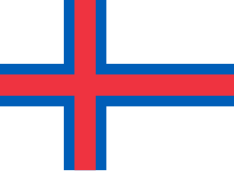Flag of Faroe Islands
 |
|
| Name | Merkið |
|---|---|
| Use | National flag and civil ensign |
| Proportion | 5:7 |
| Adopted | 25 April 1940 |
| Design | A blue-fimbriated red Nordic cross on a white field |
| Designed by | Jens Oliver Lisberg |
The flag of the Faroe Islands is an offset cross, representing Christianity. It is similar in design to other Nordic flags – a tradition set by the Dannebrog of Denmark, of which the Faroe Islands are an autonomous country.
The flag is called Merkið, which means "the banner" or "the mark". It resembles the flags of neighbouring Norway and Iceland.
The design of the flag incorporates a red Nordic cross, which is offset to the left. The red cross is fimbriated azure and is set on a white field. The flag design closely resembles that of the Norwegian flag, with the fimbriated cross. The flag proportion is usually 5:7.
White symbolises the creators of the flag, the foam of the sea and the pure, radiant sky of the Faroe Islands, while the old Faroese blue and red colours are reminiscent of other Scandinavian and Nordic flags; representing the Faroe Islands' bonds with other Nordic countries.
The modern Faroese flag was devised in 1919 by Jens Oliver Lisberg and others while they were studying in Copenhagen. The first time Merkið was raised in the Faroe Islands was on 22 June that year in Fámjin on the occasion of a wedding. On 25 April, 1940, the British occupation government approved the flag for use by Faroese vessels, during the tenure of Carl Aage Hilbert as Danish prefect. Britain did not want the same flag as German occupied Denmark to be used. April 25 is still celebrated as Flaggdagur and it is a national holiday. With the Home Rule Act of 23 March, 1948, the flag was recognized by the Danish Government as the national flag of the Faroes. The original flag is displayed in the church of Fámjin in Suðuroy.
...
Wikipedia
